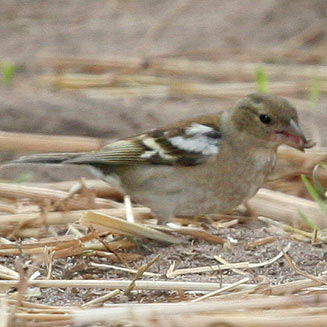|
Fringilla coelebs (Common
chaffinch, Chaffinch)
Gryskoppie [Afrikaans]; Vink [Dutch]; Pinson des arbres
[French]; Buchfink [German]; Tentilhão-comum [Portuguese]
Life
> Eukaryotes >
Opisthokonta
> Metazoa (animals) >
Bilateria >
Deuterostomia > Chordata >
Craniata > Vertebrata (vertebrates) > Gnathostomata (jawed
vertebrates) > Teleostomi (teleost fish) > Osteichthyes (bony fish) > Class:
Sarcopterygii (lobe-finned
fish) > Stegocephalia (terrestrial
vertebrates) > Tetrapoda
(four-legged vertebrates) > Reptiliomorpha > Amniota >
Reptilia (reptiles) >
Romeriida > Diapsida > Archosauromorpha > Archosauria >
Dinosauria
(dinosaurs) > Saurischia > Theropoda (bipedal predatory dinosaurs) >
Coelurosauria > Maniraptora > Aves
(birds) >
Order: Passeriformes > Family: Fringillidae
 |
|
|
Common chaffinch, Hout Bay, Western Cape, South
Africa. [photo
Duncan Robertson ©] |
|
Distribution and habitat
Occurs from Europe to western Asia but was introduced to
Cape Town, South Africa in ca. 1898, where it is locally common from Rondebosch
to Tokai. It almost exclusively occupies plantations, alien woodlands, parks and
gardens, rarely moving into mountain fynbos.
Movements and migrations
Largely resident and sedentary, although it may
make local movements in the period from March-September.
Food
It mainly eats insects and seeds, doing most of its
foraging on the ground and in the canopy of trees. The following food items have been recorded
in its diet:
- Plants
- seeds
- Acacia (alien wattles)
- grain
- Pinus (pines)
- small fruit
- leaf buds
- Invertebrates
Breeding
- Although its breeding habits are little known in South Africa, it is
though to be a monogamous, territorial solitary nester.
- The nest is built solely by the female, consisting of a small cup of
moss, grass stems, rootlets and hair, bound together with spider web and
lined with feathers, hair, plant down and other soft material. It is
typically placed in an alien bush or tree, usually from 3-10 metres above
ground.
- Egg-laying season is from September-November.
- It lays about 3-4 eggs, which are incubated solely by the female for
about 12-13 days.
- The chicks are fed mainly by their mother, leaving the nest after
roughly 12-13 days and remaining dependent on their parents for
approximately another 25 days (recorded in Europe).
Threats
Since it is introduced it is not of conservation concern
and it seems to have had little impact on indigenous flora and fauna.
References
-
Hockey PAR, Dean WRJ and Ryan PG 2005. Roberts
- Birds of southern Africa, VIIth ed. The Trustees of the John Voelcker
Bird Book Fund, Cape Town.
|
